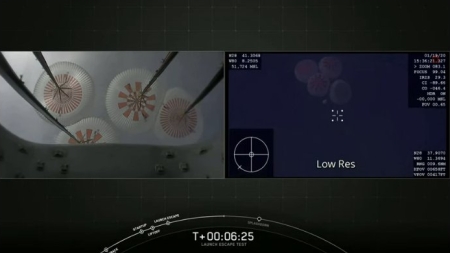NASA leaning towards long-duration flight for 1st Dragon mission
Capitalism in space: According to one former astronaut as well as a review of photos of the training being given to the astronauts who will fly on SpaceX’s first manned Dragon flight, this Space News article thinks that NASA will make that first flight a long-duration mission.
This Dragon demo mission is officially still planned as a short mission, no more than two weeks. To extend it requires additional training, which the photos appear to show, and would thus delay its launch by as yet an unspecified time period.
The article also cites a third reason NASA is now favoring the long-duration option: The issues with Boeing’s manned Starliner capsule:
Another factor in any decision to extend Demo-2 is the status of the other commercial crew vehicle, Boeing’s CST-100 Starliner. That vehicle flew an uncrewed test flight in December, but software problems during the flight, including one which shortened the mission and prevented a docking with the ISS, have raised questions about whether a second uncrewed test flight will be needed. An investigation into those problems is expected by the end of this month.
Even if NASA decides a second uncrewed test flight of Starliner is not needed, a review of all of the spacecraft’s one million lines of code, and other reviews, is likely to delay a crewed test flight of the spacecraft. NASA and Boeing had previously agreed to make that test flight a long-duration mission, with NASA astronauts Mike Fincke and Nicole Mann and Boeing astronaut Chris Ferguson performing space station training in addition to that for the Starliner itself.
The delay in Boeing’s long duration mission leaves a gap in the schedule for maintaining crews on ISS. Flying Dragon long-duration would help solve that.
Capitalism in space: According to one former astronaut as well as a review of photos of the training being given to the astronauts who will fly on SpaceX’s first manned Dragon flight, this Space News article thinks that NASA will make that first flight a long-duration mission.
This Dragon demo mission is officially still planned as a short mission, no more than two weeks. To extend it requires additional training, which the photos appear to show, and would thus delay its launch by as yet an unspecified time period.
The article also cites a third reason NASA is now favoring the long-duration option: The issues with Boeing’s manned Starliner capsule:
Another factor in any decision to extend Demo-2 is the status of the other commercial crew vehicle, Boeing’s CST-100 Starliner. That vehicle flew an uncrewed test flight in December, but software problems during the flight, including one which shortened the mission and prevented a docking with the ISS, have raised questions about whether a second uncrewed test flight will be needed. An investigation into those problems is expected by the end of this month.
Even if NASA decides a second uncrewed test flight of Starliner is not needed, a review of all of the spacecraft’s one million lines of code, and other reviews, is likely to delay a crewed test flight of the spacecraft. NASA and Boeing had previously agreed to make that test flight a long-duration mission, with NASA astronauts Mike Fincke and Nicole Mann and Boeing astronaut Chris Ferguson performing space station training in addition to that for the Starliner itself.
The delay in Boeing’s long duration mission leaves a gap in the schedule for maintaining crews on ISS. Flying Dragon long-duration would help solve that.

